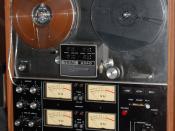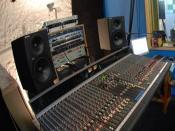"A person new to the recording studio environment might be awestruck by the amount and variety of equipment involved" (Huber 1). Electric technology began to evolve in the twenties. Visionaries had begun experimenting with all sorts of electrified instruments. By the end of the 1920's, phonographs had switched to electronic sound amplification (Gruhn 6). Eighty years later, we came up with all sorts of things that those early pioneers of the twenties could have ever dreamed. There are many different recording techniques and technologies in today's studio business.
To fully understand the different techniques and technologies in the studio business, one would need to know exactly what a studio is. A studio is a room acoustically tuned for the purpose of getting the best sound possible on tape while using a microphone pickup. In other words, the studio needs to be structurally isolated in order to keep outside sounds from entering the room and getting on tape.
The studio is also designed to keep internal sounds form leaking out and disturbing the surrounding environment. There are many types of studios. They vary in size, shape, and acoustic design in accordance with the personal tastes of the owners (Huber 1). For example, a studio that records a great deal of rock music might be small in size with highly absorbent walls. On the other hand, a recording studio designed for orchestral film scoring would be much larger by comparison, possibly with high ceilings. Some of the first studios back in the fifties and sixties were relatively large in size. Recording studios have generally decreased in size over the last two decades (Huber 2). This is mainly due to the fact that in the fifties and sixties the musicians had to perform at the same time.
Today, technology allows musicians to come...



Well written
I like the parenthetical documentation. It shows that a lot of work went into the creation of this essay, and that it is very thorough, and has strong support. Well done.
0 out of 0 people found this comment useful.